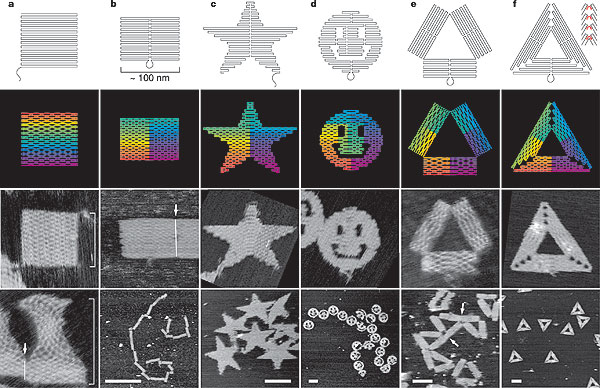What the lay audience imagine regarding the future of "nanotechnology"
<https://www.youtube.com/watch?v=cG9P8DLuh0U>
While most people imagine nanotechnology is a futuristic endeavor, it is important to realize how the world of biological chemistry and material science has already set a precedence in the field.
For the past year, I led a group of undergraduate students to compete for a bimolecular nanotechnology contest to fold DNA origami. DNA, which has inspired countless artworks in and of itself, can undergo chemical reactions to fold into a desired pattern. For our competition, our goal was to create the most unique and useful structure out of DNA. In the past people have created anything ranging from molecular robots to spiders and even computer from DNA as seen above. Creative designs such as the images below could be generated from designing DNA in a particular pattern and undergoing a one step chemical reaction. Essentially, art does not have to be limited to the canvas, or even petri dish!
 |
| Literal DNA Origami artwork where DNA is folded and used to create art at the nanometer scale
<https://www.google.com/search?safe=off&q=dna+origami>
|
A large
part of my our comes down to reconstruct biological structures at a nano-scale
level. Due to the small physical limitations of the samples I work with, they
are usually only seen in black and white or better known as gray scale. Yet, a
quick glance at any biology textbook would reveal proteins and bacteria in all
sorts of colorful variations that can almost be described as artistic. After
joining a nanobiology laboratory, I never realized the level of artistic
creativity that was asked from me.
A textbook like example of semliki-forest-virus capsid, one of the first viruses ever studied, displayed for viewing purposes after custom artwork generation from the original raw data obtained from structural reconstructions. This is an example of the artistic requirement for scientists. Color application and 3D appearance is based on modifications from original data.
<http://www.gettyimages.com/detail/illustration/style-illustration-of-semliki-forest-virus-1dyl-stock-graphic/121843605>
References:
Rothemund, Paul. "Paul Rothemund: The Astonishing Promise of DNA Folding." YouTube. YouTube, n.d. Web. 14 Apr. 2015. <https://www.youtube.com/watch?v=WhGG__boRxU>.
Stella E. Aniagyei, Christopher DuFort, C. Cheng Kaob and Bogdan Dragnea, Self-assembly approaches to nanomaterial encapsulation in viral protein cages, J. Mater. Chem., 2008,18, 3763-3774 DOI: 10.1039/B805874C <http://pubs.rsc.org/en/content/articlelanding/2008/jm/b805874c#!divCitation>
"Surface Studies with a Scanning Tunnelling Microscope [english]." YouTube. Archimedes Exhibitions GmbH, n.d. Web. 23 Apr. 2015. <https://www.youtube.com/watch?v=wNEqRq6NyUw>.
Zhou, Hong. "The building of the Titan Krios | Electron Imaging Center for Nanomachines." The building of the Titan Krios | Electron Imaging Center for Nanomachines. N.p., 10 Aug. 2006. Web. 24 Nov. 2013. <http://www.eicn.ucla.edu/titanbuildup>.

Thank you for your interesting post! :)
ReplyDeleteI am super fascinated with the DNA origami part! It is very impressive that you led a group of students in a DNA origami competition. I love how you pointed out the art behind the proteins and bacteria pictures in your biology textbook. I focused more in my blog on how nanotechnology also helped art improve in terms of art preservation and how nanoart improves science. I would have loved for you to elaborate more on how nanoart innovated scientific achievements.
I found your insight this week on nanotechnology incredibly interesting, as it portrayed how we learned in the first week of this course that art and science are intrinsically intertwined. You mentioned that your position in a nanobiology laboratory required artistic creativity. I used to work in an orthopedics lab that examined bone macrostructures and I never knew how something we often take for granted could be so intricate and beautiful. I guess sometimes it takes a combination of hours of closely staring at something and retrospection for me to truly appreciate it! Perhaps you will feel this way about your gray scale samples some day.
ReplyDelete